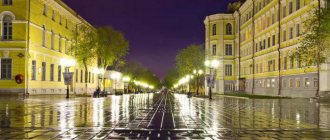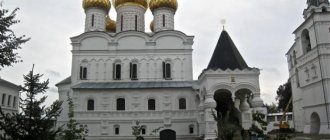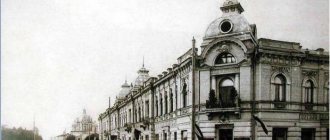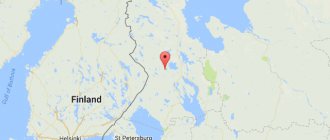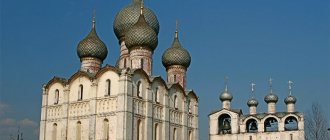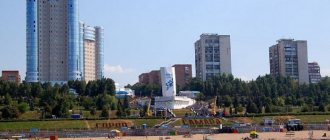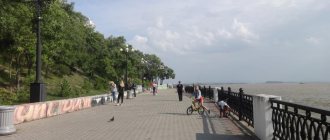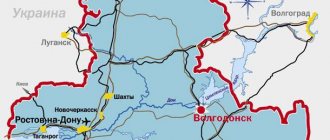City in Russia
For Omsk steamships, see PS Omsk.
City in Omsk region, Russia
| Omsk Omsk | |
| City[1] | |
| Vertex : Omsk State Academic Drama Theatre, Fire observation tower (from left to right) | |
| Flag Coat of arms | |
| Location of Omsk | |
| Omsk Location of Omsk Show map of Russia Omsk Omsk (Omsk region) Show map of Omsk region | |
| Coordinates: 54°59'N 73°22'E / 54.983°N Latitude 73.367°E / 54.983; 73.367Coordinates: 54°59'N 73°22'E / 54.983°N Latitude 73.367°E / 54.983; 73.367 | |
| A country | Russia |
| Federal subject | Omsk region[1] |
| Based | August 2, 1716[2] |
| City status from | 1782[3] |
| Government | |
| • Body | City Council[4] |
| • Mayor[5] | Oksana Fadina[5] |
| Square [3] | |
| • General | 572.9 km2 (221.2 sq mi) |
| Height | 90 m (300 ft) |
| population (2010 Census)[6] | |
| • General | 1,154,116 |
| • Evaluate (2018)[7] | 1,172,070 (+1.6%) |
| • Classify | 7th in 2010 |
| • Density | 2,000/km2 (5,200/sq mi) |
| Administrative status | |
| • Subordinate | city of regional significance of Omsk[1] |
| • Capital from | Omsk region[1], city of Omsk of regional significance[1] |
| Municipal status | |
| • Urban district | Omsk city district[8] |
| • Capital from | Omsk city district[8] |
| Timezone | UTC + 6 (MSK + 3 [9]) |
| Postal code(s)[10] | 644xxx |
| Dial code(s) | +7 3812[11] |
| OKTMO I WOULD | 52701000001 |
| Day of the city | First Saturday in August[12] |
| Web site | www.admomsk.RU |
Omsk
(/ɒмsk/; Russian: Омск, IPA: [омск]; Siberian Tatar: Kara-tora) is a city and administrative center of Omsk Oblast, Russia, located in southwest Siberia 2,236 km (1,389 mi)[13] from Moscow . With a population of 1,154,116 people, it is Russia's third largest city east of the Ural Mountains after Novosibirsk and Yekaterinburg, and the seventh largest nationally.[6] Omsk acts as an important transport hub, serving as a station for the Trans-Siberian Railway and as a springboard for the Irtysh River.
During the Imperial era, Omsk was the residence of the Governor-General of Western Siberia, and later of the Governor-General of the Steppe. For a short period during the Russian Civil War in 1918–1920. it was the capital of the anti-Bolshevik Russian state and held the imperial gold reserves.
Omsk serves as the episcopal vision of the Bishop of Omsk and Tara, as well as the administrative residence of the Imam of Siberia. Mayor of the city Oksana Fadina.
Content
- 1 History 1.1 Soviet period
- 1.2 Post-Soviet period
- 2.1 Location
- 6.1 Education
- 9.1 Athletes
- 12.1 Notes
Story
See also: Chronology of Omsk
The creation of the Omsk fortress, like other fortresses of the Upper Irtysh, was caused by the urgent need to strengthen the trade route to China. The credit for their arrangement goes entirely to the Siberian governor, Prince M.P. Gagarin. However, he also bears a large share of responsibility. Gagarin, being the governor of Nerchinsk, and then the head of the Siberian Order and the Siberian Province, devoted a lot of time and effort to trade with China. And above all, the organization of a trade route to this country. The main route ran from Tobolsk down the Irtysh, then up the Ob, then along the Ketsky volost to the Yenisei and further to the border with China. The journey was long, difficult and expensive. There was a second option - up the Irtysh, half as long and much easier. Kalmyk, Kyrgyz-Kaysak and Chinese leaders were interested in this route, since they all had their share of international trade. However, above the mouth of the Om, trade caravans were attacked by free detachments of Kalmyks (Oirats) and Kyrgyz-Kaisaks, with whom their rulers could not cope. Reliable security was needed and placed in stationary fortifications. One way or another, in May 1714, the Siberian governor obtained the tsar’s consent to build fortresses along the Irtysh and further along the existing trade route: in his report to the tsar on May 22, 1714, Gagarin substantiated the need to build fortresses along the river. Irtysh with the need to ensure communication and safety of the expedition going to the city of Yarkand for golden sand. The gold deposit was located beyond the Tien Shan ridges, on the territory of a neighboring state, in the Taklamakan desert. Prince Gagarin understood the consequences of this adventure, which, with a positive result, threatened a military conflict with China and Dzungaria. Of course, the Siberian governor did not expect that the military expedition would reach Yarkand. It was almost impossible and unnecessary. But the fortresses on the trade route will remain. And indeed, they remained. The Tsar believed the governor and signed a decree on organizing an expedition under the command of the former guards captain, Lieutenant Colonel Ivan Bukholts, and, accordingly, on the construction of fortresses on the Irtysh, above Yamyshev.[14][15][16]
On January 2, 1716, Matvey Petrovich Gagarin began his duties as governor and again actively began building fortresses in Siberia, including on Lake Kosogol, on the Yenisei and Irtysh rivers. Between 8 and 10 January 1716, the prince meets with the king and makes him an offering of a gold collection from ancient burial mounds looted along the coast. Ishim and Irtysh. At the meeting, Gagarin reported to Peter about his plans for the development of Siberia and received royal permission, presumably in the form of an imperial decree. On January 27, 1716, Peter I left for Europe, where he stayed until October 1717 and stopped receiving timely and reliable information from Siberia. In January 1716, Gagarin (with reference to the royal decree) issued his own order on the construction of a fortress on the border lake Kosogol, and in April - on the construction of fortresses on the Upper Yenisei.
On April 28, Bukholtz’s detachment left the Yamyshev fortress and moved along the Irtysh to the territory of the Tara region. Gagarin assessed the situation and gave instructions to Lieutenant Colonel Bucholz and the commandant of Tara to build a fortress at the mouth of the river. and sent recruits for reinforcements. By the end of 1716, the first fortress (fortified place) was built on the territory of the modern river station. It consisted of a pentagonal earthen fortress, gunpowder and food warehouses, barracks for soldiers, and houses for officers. The first Omsk fortress (fortified place) was practically a copy of the fortress built in 1715 near Lake Yamyshevskoye. And, accordingly, it carried the main drawback: the fortifications were scattered, the external fence was weak. When attacked by the enemy, the entire garrison had to defend the fortress objects separately from each other, which happened in 1716 during the defense of the Yamyshev fortress. The unsuccessful layout of the first Yamyshevskaya and Omsk fortresses was explained, first of all, by the lack of fortification experience among the builders.[17][18]
At the beginning of 1717, dragoon captain Ilya Gavrilovich Aksakov was invited from Russia. The governor rewards him with major and instructs him to lead the construction of a new (second) fortress at the mouth of the river. In the summer of the same year, the Omsk garrison under the command of Stupin went to the upper reaches of the Irtysh to build fortresses. Lieutenant Colonel Ivan Buholts categorically refused to lead a new expedition and in March 1717 he was sent from Tobolsk to the capital. There is very little information about the founding of the Omsk settlement and the construction of the second fortress. One of the most valuable sources of information is the list of documents from the Tara Chancellery, copied for Professor G.F. Miller in 1734. Professor V.I. mentioned this equipment. Kochedamov in 1960, and in 2015 it was published by Barnaul scientists V.B. Borodaev, A.V. Contev.[19] However, there are no drawings and, accordingly, it is unknown where and how to build a new city (fortress). A drawing “On the structure of the Omsk fortress behind the river prison and courtyards in a line” was sent from Tara to the Omsk fortress. In 1722, this drawing was used by captain-engineer Paul de Grange when developing a plan for a fortress on the right bank of the Om. At the end of the summer of 1717, Gagarin ordered the production of six bells for the Yamyshev and Omsk fortresses. The bells were produced by the military department in the amount of three per fortress. According to the drawing of the Omsk fortress of 1717, this is: a triangular guard redoubt at the mouth of the Om; a quadrangular fortress at the crossing of the Om and a pentagonal fortress at the yard. At the beginning of 1718, seven bells were made. Perhaps the seventh was intended for the Omsk settlement, on the right bank of the river. . It is not yet known whether the quadrangular fort and triangular redoubt were built. However, it is known for certain that the fortress (defensive structure) was built in a pentagonal shape, although not as regular as in the drawing. This is evidenced by the plans of 1745 and 1755. Moreover, the entire settlement (Omsk fortress, including the Cossack settlement and the main defensive structure) had the shape of an irregular broken quadrangle.[20]
In 1768, the Om fortress was moved. The original Tobolsk and restored Tara gates, together with the original German Lutheran church and several public buildings of the time. Omsk received city status in 1782.[21]
In 1822, Omsk became the administrative capital of Western Siberia, and then, in 1882, the center of the vast steppe region (today the northern part of Kazakhstan) and the Akmola region, in particular, the acquisition of several churches and cathedrals of various denominations, mosques, a synagogue, the mansion of the Governor General and military academy.[22] But as the frontier retreated and its military importance diminished, the city fell into lethargy. At that time, Omsk became a major center of Siberian exile. From 1850 to 1854 Fyodor Dostoevsky served his sentence in Omsk hard labor prison.
Inside the Omsk settlement (city of Omsk), a military settlement - the Omsk Fortress - lived its own life for about 150 years. By 1845, the structures of the Omsk fortress were half destroyed, which prompted the engineering department of the military department to petition for the abolition of the fortress. In 1864 the fortress was abolished.
The catalyst for the city's development was the construction of the Trans-Siberian Railway in the 1890s, which influenced Omsk's importance as a logistics hub. Many trading companies opened stores and offices in Omsk, which determined the character of the city center. British, Dutch and German consulates were created around the same time to represent their commercial interests. The pinnacle of development in pre-revolutionary Omsk was the Siberian Agro-Industrial Exhibition of 1910. The popularity of the World's Fairs contributed to the formation of the image of Omsk as "Chicago from Siberia".[23]
Soon after the October Revolution, anti-Bolshevik White forces seized control of Omsk. A "Provisional All-Russian Government" was founded here in 1918, headed by an Arctic explorer and decorated war hero. Admiral Kolchak. Omsk was proclaimed the capital of Russia, and its central bank was tasked with storing the gold reserves of the former empire. They were guarded by a garrison of former Czechoslovak prisoners of war who ended up in Siberia due to the chaos of the First World War and the subsequent revolution.[ citation needed
] Omsk became the main target of the Red Army leadership, who saw it as the main target of their Siberian campaign and eventually forced Kolchak and his government to abandon the city and retreat along the Trans-Siberian Railway east to Irkutsk. In 1919, Bolshevik troops entered the city.
Soviet period
State Library named after.
A.S. Pushkin , the Soviet government preferred young Novonikolaevsk (later known as Novosibirsk) as the administrative center of Western Siberia, which led to a massive transfer of administrative, cultural and educational functions from Omsk. This somewhat slowed the growth of Omsk and provoked ongoing rivalry between the two cities.[24] Omsk received new life as a result of the Second World War. Since Omsk was far from the fighting and had a well-developed infrastructure, Omsk became an ideal refuge for most of the industry evacuated from the front line in 1941. In addition, contingency plans were developed to move the temporary Soviet capital to Omsk. event of the German victory during the Battle of Moscow (October 1941 - January 1942).[25] At the end of the war, Omsk remained a major industrial center, subsequently becoming the leader of Soviet military production.
Leningradsky Bridge over the Irtysh
The military industry that moved to Omsk included part of the OKMO Tank Design Bureau 1941, S.M. Kirov plant No. 185 from Chelyabinsk, 1962. Kirov Plant and Omsk Transmash Design Bureau (KBTM) manufactured T-80 tanks of the 1970s, and were responsible for the BTR-T, TOS-1, and the prototype Black Eagle Tank. Omsk Transmash declared bankruptcy in 2002.
In the 1950s, after the development of oil and gas fields in Siberia, an oil refining complex was built along with an entire “oil town”, expanding Omsk north along the coast. Irtysh. Currently, this is the largest complex of its kind in Russia. Gazprom Neft, the parent company, is the city's largest employer, using its tax rates as leverage in negotiations with municipal and regional authorities.
Post-Soviet period
After the collapse of the Soviet Union, Omsk experienced a period of economic instability and political stagnation. Most of the city's large enterprises, previously owned by the state, were run by the former party elite. nouveau riche, and fast-growing crime syndicates. The most high-profile cases concerned the privatization of Sibneft, a large oil company that had existed for several years. Until the end of the 1990s. The political life of Omsk was determined by the ongoing hostility between regional and city authorities. The resulting conflict made at least two points of view accessible to the public and inspired some improvements to the city's infrastructure and cultural life. These include the construction of new recreation parks and the reconstruction of the historical city center, the establishment of the annual Siberian International Marathon, and the annual City Days festival. Despite this, internal political competition has depleted Omsk's resources and become a serious obstacle to the smooth functioning of the government and the development of the city.
Geography
Location
Omsk is located in the south of the West Siberian Plain along the banks of the northern Irtysh at its confluence with the Om River. The city is at an altitude of 87 meters (285 feet). above mean sea level at its highest point.
Omsk is an important railway junction and a junction point of the northern and southern branches of the railway. Trans-Siberian Railway. The city is also a major hub of the regional highway network. River port facilities serve both passengers and cargo, giving the city access to navigation along the vast Irtysh and Ob River waterways. Waterways connect Omsk to coal and mining towns upriver in Kazakhstan, as well as to the oil, natural gas and logging regions of northern Siberia. Omsk is served by the Central Airport, which offers access to domestic and international (mainly German and Kazakh) destinations, making the city an important aviation hub for Siberia and the Russian Far East.
It is approximately 450 km (280 miles) north of the capital of Kazakhstan. Nur-Sultan, and 600 km (370 miles) west of Siberia's largest city Novosibirsk.
Climate
Omsk has a humid continental climate characterized by sudden changes in weather. Average daily temperatures taken over the last three decades are +20 °C (68 °F) in July and -17 °C (1 °F) in January, although temperatures can very rarely reach +40 °C (104 °F). ) in summer and very rarely drop to -45 °C (-49 °F) in winter. On average, Omsk has more than 300 sunny days a year (2201 hours). The average annual precipitation is 415 millimeters (16.3 in).
| Climate data for Omsk | |||||||||||||
| Month | Jan | Feb | Mar | Apr | May | Jun | Jul | Aug | Sep | October | But I | December | Year |
| Record high °C (°F) | 4.2 (39.6) | 8.0 (46.4) | 14.1 (57.4) | 31.3 (88.3) | 35.5 (95.9) | 40.1 (104.2) | 40.4 (104.7) | 38.0 (100.4) | 32.9 (91.2) | 27.4 (81.3) | 16.1 (61.0) | 4.5 (40.1) | 40.4 (104.7) |
| Average high °C (°F) | −12 (10) | −10.3 (13.5) | −2.5 (27.5) | 9.1 (48.4) | 19.0 (66.2) | 23.9 (75.0) | 25.3 (77.5) | 22.7 (72.9) | 15.9 (60.6) | 8.1 (46.6) | −3.7 (25.3) | −9.8 (14.4) | 7.1 (44.8) |
| Daily average °C (°F) | −16.3 (2.7) | −15.0 (5.0) | −7.3 (18.9) | 3.7 (38.7) | 12.5 (54.5) | 18.0 (64.4) | 19.6 (67.3) | 16.9 (62.4) | 10.4 (50.7) | 3.5 (38.3) | −7.3 (18.9) | −13.8 (7.2) | 2.1 (35.8) |
| Average low °C (°F) | −20.5 (−4.9) | −19.4 (−2.9) | −12 (10) | −1.0 (30.2) | 6.3 (43.3) | 12.0 (53.6) | 14.2 (57.6) | 11.6 (52.9) | 5.7 (42.3) | −0.3 (31.5) | −10.5 (13.1) | −17.9 (−0.2) | −2.7 (27.1) |
| Record low °C (°F) | −45.1 (−49.2) | −45.5 (−49.9) | −41.1 (−42.0) | −26.4 (−15.5) | −12.9 (8.8) | −3.1 (26.4) | 2.1 (35.8) | −1.7 (28.9) | −7.6 (18.3) | −28.1 (−18.6) | −41.2 (−42.2) | −44.7 (−48.5) | −45.5 (−49.9) |
| Average precipitation mm (inches) | 23 (0.9) | 18 (0.7) | 17 (0.7) | 21 (0.8) | 35 (1.4) | 51 (2.0) | 66 (2.6) | 54 (2.1) | 37 (1.5) | 30 (1.2) | 34 (1.3) | 29 (1.1) | 415 (16.3) |
| Average rainy days | 1 | 0.4 | 3 | 10 | 17 | 17 | 18 | 19 | 18 | 13 | 5 | 1 | 122 |
| Average snow days | 28 | 25 | 18 | 9 | 2 | 0.2 | 0 | 0 | 1 | 11 | 22 | 28 | 144 |
| Average relative humidity (%) | 80 | 78 | 76 | 64 | 54 | 60 | 68 | 70 | 70 | 74 | 81 | 81 | 71 |
| Average monthly sunshine | 68 | 125 | 184 | 235 | 284 | 319 | 321 | 248 | 180 | 105 | 71 | 61 | 2,201 |
| Source 1: Pogoda.ru.net[26] | |||||||||||||
| Source 2: NOAA (Sun, 1961–1990).[27] | |||||||||||||
National composition
The ethnic composition of the Omsk region is very diverse. There are 35 nationalities recorded in the region. Most of all Russians live in the region. Their number is 85% of the total number of residents of the region.
In all districts of the Omsk region, the Russian population is represented in the absolute majority. In some, this figure exceeds 90%. The fewest Russians live in the Pavlogradsky district - only 52%. 24% of Ukrainians and 16% of Kazakhs also live here.
The Chuvash population of the Omsk region is among the ten largest diasporas in the region. According to the latest census, more than three thousand Chuvash live in this Siberian region. Also, the top ten largest nationalities include, in addition to Russians, Ukrainians, Kazakhs, Germans, Tatars, Armenians, Belarusians, Azerbaijanis and Uzbeks.
The region is also home to such rare nationalities as Finns (about 200 people), Greeks (about 500 people) and Chinese - almost 800 inhabitants.
Architecture
Omsk Assumption Cathedral
The architectural center of the city is an ensemble of buildings along Lyubinsky Prospect/Lenin Street, anchored by the former Gostiny Dvor, and between two chapels. The area is an eclectic mix of architectural styles, dominated by Art Nouveau, Neoclassicism and Second Empire.
Closer to the confluence of the Oma and Irtysh there are several surviving gloomy buildings of the 18th century fortress. The largest and most luxurious church in the city is the Assumption Cathedral, a five-domed building in the Russian Revival style, consecrated in 1896, demolished by the Soviet Union and rebuilt in the first decade of the 21st century.[ citation needed
]
Another attraction is Nikolsky Prospekt - Krasnye Zory Street, where a row of merchant wooden houses still stands. The street leads to the Neoclassical Cathedral of St. Nicholas, which was commissioned by the Cossacks, designed by Vasily Stasov and consecrated in 1840. It contains various relics of the Siberian Cossacks.[30]
- Tarskaya street
- Fountain on Theater Square
Districts of Omsk region
There are 32 districts on the territory of the Omsk region. The largest are Omsk, Tara and Tavrichesky districts.
The population of the Omsk region is more than 100 thousand people, the administrative center is in the village of Rostovka. About 45 thousand people live in the Tara district (the administrative center is in the city of Tara), and about 36 thousand people live in the Tavrichesky district (the administrative center is in the working village of Tavrichesky).
The village of Znamenskoye, Omsk region, requires special mention. This is the center of the Znamensky district. Several large Siberian rivers are concentrated in it - the Irtysh, Osha, Bolshoi Aev, Bolshoi Nyagov and Shish.
The village of Znamenskoye, Omsk Region, is a striking example of a dying settlement. If before the Great Patriotic War almost 40 thousand people lived in the area, today there are about 11 and a half thousand left. At the same time, a little more than 5 thousand people live in Znamensky itself.
Life and culture
As a major educational center, Omsk has a number of museums, theaters, concert venues and educational institutions.
Omsk Vrubel Museum
Among the Omsk museums the following stand out:
- State Museum of Local Lore
- Dostoevsky Literary Museum[31]
- Museum of Fine Arts. Vrubel[32]
- Military museum complex
- Kondraty Belova Art Museum
- Liberov Arts Center
Theaters include the Omsk Opera, Omsk Drama Theatre, Omsk Circus, Omsk State Musical Theater and a number of small venues.
Education
Omsk State Transport University
Omsk is home to many higher educational institutions and several universities:
- Institute of Law and Economics
- Omsk Law Academy
- Omsk Academy of the Ministry of Internal Affairs of Russia
- Omsk Aviation College
- Omsk Institute of Foreign Languages
- Omsk State Medical University
- Omsk State Transport University (1961)
- Omsk State Agrarian University (1918) (connected with the Omsk State Veterinary Institute and the Institute of Agribusiness and Continuing Education)
- Omsk State Pedagogical University
- Omsk State University (1974)
- Omsk Institute of Consumer Services Technologies
- Omsk State Technical University (1942)
- SibADI - (Russian: Siberian Automobile and Road InstituteSiberian State Automobile and Highway Academy (formerly institute)
- SibGUFK - (Russian: Siberian State University of Physical Culture) Siberian Academy of Physical Culture
- Siberian Institute of Business and Information Technologies
- Modern Municipal University
- SIBNFOR - Siberian Institute of Stock Market
Sports
Arena Omsk
Omsk in the republic is represented by professional associations of football and hockey clubs.
| Club | Sport | Based | Current league | League classify | Stadium |
| Avangard Omsk | Ice hockey | 1950 | Kontinental Hockey League | 1st | Omsk Arena |
| Omsk Hawks | Ice hockey | 2009 | Minor Hockey League | Junior 1st | Omsk Arena |
| Hawks Omsk | Ice hockey | 2012 | Minor Hockey League Division B | Junior second | Omsk Arena |
| Omichka Omsk | Volleyball | 1965 | Women's Volleyball Super League | 1st | Blinov SKK |
| Omichka-2 | Volleyball | 2009 | Women's Major League | 2nd | SK Ermak |
| Irtysh Omsk | Football | 1946 | Russian Second Division | 2nd | Red Star Stadium |
| Neftyanik Omsk | Basketball | 1965 | Basketball Super League B | 3rd | Sports complex Sibirsky Neftyanik |
Transport
Picture Omsk Station
Omsk is a large railway, automobile and aviation hub. The city is served by a station on the Trans-Siberian Railway, and by the Central Airport. In addition, Omsk has a river port on the Irtysh, serving domestic flights and cities of Kazakhstan.
Urban transport consists of a large bus, trolleybus and tram network, although the latter has deteriorated greatly since the collapse of the USSR. minibuses
(minibus taxis) complement municipal transport networks.
And the metro system, proposed in the late 1980s but shelved due to lack of funds, is currently under construction. Irtysh River. The bridge is already open to cars (upper level), but the subway (lower level) is still under construction. As a first step, one short line will connect areas in the northwest to the city center. As of 2022, only one station is open, which serves as a pedestrian metro.
Lifespan
Life expectancy in the region was first recorded in 1990. Then it was almost 70 years. Until 1994, life expectancy declined sharply, reaching approximately 65 and a half years.
Since the mid-90s it began to grow again. In recent years, there has been an increasing trend towards an increase in average life expectancy in the Omsk region. According to the latest data, this figure is almost 70 years. It was the same in 1990, when statistics were just starting to be kept.
Today, the Omsk region is experiencing certain problems with population growth, since the number of people traveling outside the region exceeds those who choose Omsk as their new place of life.
Famous people
Main article: List of people from Omsk
- Eva Elfi, actress
- Innokenty Annensky, poet
- Nina Arkhipova, actress
- Vladislav Artemyev, chess player
- Fyodor Dostoevsky, writer and publicist, in exile 1849–1854.
- Vladislav Dvorzhetsky, actor
- Wacław Iwaszkiewicz-Rudoszanski, Polish general
- Anatoly Josepho, inventor
- Eduard Kunz, pianist
- Dmitry Yazov, Russian general
- Dmitry Karbyshev, General
- Vilis Kristopans, former Prime Minister of Latvia
- Valerian Kuibyshevrevolutionary
- Sergei Letov, jazz musician
- Egor Letov, rock musician
- Vladimir Lukin, politician
- Leonid Martynov, poet
- Lyubov Polishchuk, actress
- Grigory Potanin, ethnographer and naturalist
- Lyudmila Radchenko, model and actress
- Vlada Roslyakova, model
- Robert Rozhdestvensky, poet
- Vissarion Shebalin, composer
- Valentina Talyzina, actress
- Mikhail Shivlyakov, Marine, strongman
- Tamara Vilerte, Latvian chess player
- Mikhail Vrubel, artist
- Mikhail Ulyanov, actor
- Nikolay Yadrintsev, researcher and archaeologist
Athletes
- Egor Averin, hockey player
- Vladimir Barnashov, biathlete and biathlon coach
- Vitalina Batsarashkina, sports shooter
- Vera Biryukova, rhythmic gymnast
- Viktor Blinov, hockey player
- Tatyana Borodulina, speed skater
- Ksenia Dudkina, rhythmic gymnast
- Dmitry Yaskin, hockey player
- Sergei Kalinin, hockey player
- Evgenia Kanaeva, rhythmic gymnast
- Yulia Kosenkova, middle distance athlete
- Vera Krasnova, speed skater
- Marat Mulashev, professional football
- Nikita Nikitin, hockey player
- Nikita Pivtsakin, hockey player
- Anastasia Reiberger, pole vaulter
- Dennis Siver, mixed martial artist
- Yuri Shatalov, hockey player
- Alexander Shlemenko, mixed martial arts fighter
- Galima Shugurova, rhythmic gymnast
- Sofia Skomorokh, rhythmic gymnast
- Roman Sloudnov, swimmer
- Alexander Svitov, hockey player
- Dmitry Sychev, association football player
- Andrey Taratukhin, hockey player
- Irina Chachina, rhythmic gymnast
- Alexey Tishchenko, boxer
- Polina Tsurskaya, figure skater
Recommendations
Notes
- ^ a b c d f f
Law No. 467-OZ - GmbH, Emporis. "Omsk - Buildings - EMPORIS". www.emporis.com
. - ^ a b
"Geography of Omsk: geographical location of the city, districts, streets in Omsk."
omsk.infomsk.ru
. - "Suffrage. Official portal of the Omsk City Administration." www.admomsk.ru
. - ^ a b
"Mayor of Omsk: Biographical information".
www.admomsk.ru
. - ^ a b c
Federal State Statistics Service of Russia (2011).
“All-Russian Population Census 2010. Volume 1" [All-Russian Population Census 2010, vol. 1]. All-Russian Population Census 2010 [All-Russian Population Census 2010]
(in Russian). Federal State Statistics Service. - "26. The size of the permanent population of the Russian Federation by municipalities as of January 1, 2022.” Federal State Statistics Service. Retrieved January 23, 2022.
- ^ a b c
Law No. 548-OZ - "On the calculation of time." Official Internet portal of legal information
(in Russian). June 3, 2011. Retrieved January 19, 2022. - Post office. Information and computing center of OASU RPO. ( Post office
).
Search for postal facilities ( Search for postal facilities
) (in Russian) - "International telephone codes - how to call from Azerbaijan - Baku to Russia - Omsk - Omsk." www.timeanddate.com
. - “Omsk City Day. Official portal of the Omsk City Administration." www.admomsk.ru
. - "Distance between Moscow, Russia and Omsk, Russia." www.mapcrow.info
. - "1717. Omsk fortress and settlement.
- Chronology of the history of Omsk (in Russian)
- "Historical background for the founding of the Omsk fortress."
- “The first Siberian governor M.P. Gagarin and the foundation of the Russian fortress on the Om River” (PDF).
- Kolesnikov A.D. Foundation of the Omsk fortress and its role in the settlement of the Irtysh region // News of the Omsk branch of the Geographical Society of the USSR. Omsk: West Siberian Book Publishing House. Omsk branch, 1965. pp. 133–135
- “The first Siberian governor M.P. Gagarin and the foundation of the Russian fortress on the Om River” (PDF).
- "1717. Omsk fortress and settlement.
- "History of the city of Omsk." www.admomsk.ru
. - Siberia and the system of exile
ISBN 978-1-108-04823-1 p. 480 - «thinkrussia.com
«. - "History of Omsk". kachaloff.narod.ru
. - Lecture 3: 3: “World War II” - the Battle of Moscow., edb.gov.hk
- “Weather and climate - climate of Omsk” (in Russian). Weather and climate (Weather and climate). Retrieved November 30, 2015.
- “Climate norms of Omsk 1961–1990.” National Oceanic and Atmospheric Administration. Retrieved November 30, 2015.
- “All-Union Population Census of 1989. The number of the actual population of the union and autonomous republics, autonomous regions and districts, territories, regions, urban settlements and villages. The population of Russia, constituent entities of the Russian Federation as part of federal districts, urban settlements, urban settlements, populated areas, settlements of 3 thousand or more people" [Population of Russia, its federal districts, federal subjects, districts, urban settlements, rural settlements - administrative centers, rural settlements with a population of more than 3000 people] (XLS). All-Russian Population Census of 2002 [All-Russian Population Census of 2002]
(in Russian). - Brumfield, William (27 September 2011). "Omsk: Garrison city on the Irtysh."
- "litmuseum - Magazine about French literature and life in France." litmuseum.ru
. - "Museum named after M. A. Vrubel." www.vrubel.ru
. - "3406 Omsk 1969 - Google Search." books.google.com
. - "Foreign partner cities of Omsk." admomsk.ru
(in Russian). Omsk Retrieved February 1, 2022.
Sources
- Legislative Assembly of the Omsk Region. Law No. 467-OZ of October 15, 2003 “On the administrative-territorial structure of the Omsk region and on the procedure for changing it,” as amended. Law No. 1591-OZ of December 10, 2013 “On amendments to certain Laws of the Omsk Region in connection with the adoption of the Federal Law “On Education in the Russian Federation””. Came into force three months from the date of official publication. Published: “Omsky Vestnik”, No. 69, October 31, 2003 (Legislative Assembly of the Omsk Region. Law No. 467-OZ of October 15, 2003 On the administrative-territorial structure of the Omsk Region and the procedure for changing it
As amended by the Law of December 10, 2013 No. 1591-OZ.
On amendments to various laws of the Omsk region in connection with the adoption of the Federal Law “On Education in the Russian Federation"
. Valid as of three months after the official date of publication.). - Legislative Assembly of the Omsk Region. Law No. 548-OZ of July 30, 2004 “On the borders and status of municipalities of the Omsk region,” as amended. Law No. 1642-OZ of June 27, 2014 “On Amendments to the Law of the Omsk Region” On the Borders and Status of Municipal Entities of the Omsk Region “”. Came into force on the date of official publication. Published: “Omsk Bulletin”, No. 45, No. 47, No. 49, August 13, 20, 27, 2004 (Legislative Assembly of the Omsk Region. Law No. 548-OZ of July 30, 2004. On the borders and status of municipalities of the Omsk Region
As amended by Law No. 1642-OZ dated June 27, 2014.
On amendments to the Law of the Omsk Region “On the borders and status of municipalities of the Omsk Region"
. Valid from the date of official publication.). - Lugovskaya, Ksenia (September 6, 2014). "Bone armor of a 3,900-year-old warrior found in Omsk." Siberian times
. Retrieved June 18, 2022.
Region area
The area of the Omsk region is more than 141 thousand square kilometers. This amounts to almost 1 percent of the entire country.
According to this indicator, the region to which this article is devoted ranks 28th in the country. Between the Republic of Bashkortostan and the Orenburg region. If we take into account only the Siberian Federal District, then in terms of area the Omsk region ranks 8th, behind the Krasnoyarsk, Altai and Transbaikal territories, the Irkutsk, Tomsk and Novosibirsk regions, and the republics of Buryatia and Tyva.

